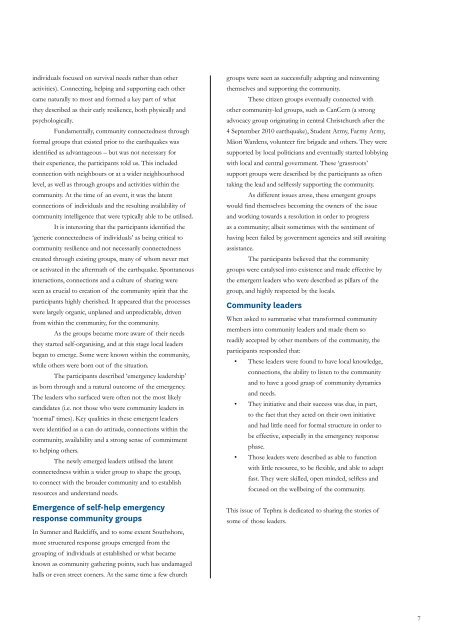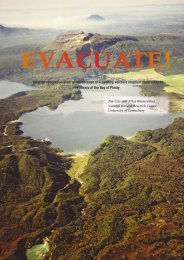Download Tephra Volume 23 (PDF, 1.33MB) - Ministry of Civil ...
Download Tephra Volume 23 (PDF, 1.33MB) - Ministry of Civil ...
Download Tephra Volume 23 (PDF, 1.33MB) - Ministry of Civil ...
Create successful ePaper yourself
Turn your PDF publications into a flip-book with our unique Google optimized e-Paper software.
individuals focused on survival needs rather than other<br />
activities). Connecting, helping and supporting each other<br />
came naturally to most and formed a key part <strong>of</strong> what<br />
they described as their early resilience, both physically and<br />
psychologically.<br />
Fundamentally, community connectedness through<br />
formal groups that existed prior to the earthquakes was<br />
identified as advantageous – but was not necessary for<br />
their experience, the participants told us. This included<br />
connection with neighbours or at a wider neighbourhood<br />
level, as well as through groups and activities within the<br />
community. At the time <strong>of</strong> an event, it was the latent<br />
connections <strong>of</strong> individuals and the resulting availability <strong>of</strong><br />
community intelligence that were typically able to be utilised.<br />
It is interesting that the participants identified the<br />
‘generic connectedness <strong>of</strong> individuals’ as being critical to<br />
community resilience and not necessarily connectedness<br />
created through existing groups, many <strong>of</strong> whom never met<br />
or activated in the aftermath <strong>of</strong> the earthquake. Spontaneous<br />
interactions, connections and a culture <strong>of</strong> sharing were<br />
seen as crucial to creation <strong>of</strong> the community spirit that the<br />
participants highly cherished. It appeared that the processes<br />
were largely organic, unplaned and unpredictable, driven<br />
from within the community, for the community.<br />
As the groups became more aware <strong>of</strong> their needs<br />
they started self-organising, and at this stage local leaders<br />
began to emerge. Some were known within the community,<br />
while others were born out <strong>of</strong> the situation.<br />
The participants described ‘emergency leadership’<br />
as born through and a natural outcome <strong>of</strong> the emergency.<br />
The leaders who surfaced were <strong>of</strong>ten not the most likely<br />
candidates (i.e. not those who were community leaders in<br />
‘normal’ times). Key qualities in these emergent leaders<br />
were identified as a can do attitude, connections within the<br />
community, availability and a strong sense <strong>of</strong> commitment<br />
to helping others.<br />
The newly emerged leaders utilised the latent<br />
connectedness within a wider group to shape the group,<br />
to connect with the broader community and to establish<br />
resources and understand needs.<br />
Emergence <strong>of</strong> self-help emergency<br />
response community groups<br />
In Sumner and Redcliffs, and to some extent Southshore,<br />
more structured response groups emerged from the<br />
grouping <strong>of</strong> individuals at established or what became<br />
known as community gathering points, such has undamaged<br />
halls or even street corners. At the same time a few church<br />
groups were seen as successfully adapting and reinventing<br />
themselves and supporting the community.<br />
These citizen groups eventually connected with<br />
other community-led groups, such as CanCern (a strong<br />
advocacy group originating in central Christchurch after the<br />
4 September 2010 earthquake), Student Army, Farmy Army,<br />
Māori Wardens, volunteer fire brigade and others. They were<br />
supported by local politicians and eventually started lobbying<br />
with local and central government. These ‘grassroots’<br />
support groups were described by the participants as <strong>of</strong>ten<br />
taking the lead and selflessly supporting the community.<br />
As different issues arose, these emergent groups<br />
would find themselves becoming the owners <strong>of</strong> the issue<br />
and working towards a resolution in order to progress<br />
as a community; albeit sometimes with the sentiment <strong>of</strong><br />
having been failed by government agencies and still awaiting<br />
assistance.<br />
The participants believed that the community<br />
groups were catalysed into existence and made effective by<br />
the emergent leaders who were described as pillars <strong>of</strong> the<br />
group, and highly respected by the locals.<br />
Community leaders<br />
When asked to summarise what transformed community<br />
members into community leaders and made them so<br />
readily accepted by other members <strong>of</strong> the community, the<br />
participants responded that:<br />
• These leaders were found to have local knowledge,<br />
connections, the ability to listen to the community<br />
and to have a good grasp <strong>of</strong> community dynamics<br />
and needs.<br />
• They initiative and their success was due, in part,<br />
to the fact that they acted on their own initiative<br />
and had little need for formal structure in order to<br />
be effective, especially in the emergency response<br />
phase.<br />
• Those leaders were described as able to function<br />
with little resource, to be flexible, and able to adapt<br />
fast. They were skilled, open minded, selfless and<br />
focused on the wellbeing <strong>of</strong> the community.<br />
This issue <strong>of</strong> <strong>Tephra</strong> is dedicated to sharing the stories <strong>of</strong><br />
some <strong>of</strong> those leaders.<br />
7

















